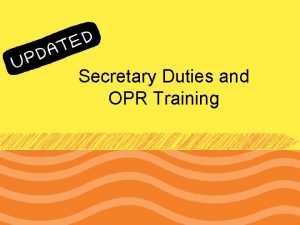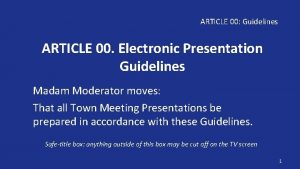Article Presentation 3 5 minutes Summary of article










































- Slides: 42

Article Presentation 3 -5 minutes Summary of article Why this issue is an important one Next steps Can send me a ppt slide

Ecological Succession where in the world am I?

Only a 3. 5 hr drive from LA

Ecological Succession • Gradual process of change and replacement of the types of species in a community. • May take hundreds or thousands of years.

While watching video 1) Which biome is Mrs. Morris-O’Hearn showing? 2) Why does she call the community a climax community? Sorry if it a bit shaky

Video

Primary succession • colonization of new sites by communities of organisms – takes place on bare rock

Primary succession • New bare rock comes from 2 sources: – 1. volcanic lava flow cools and forms rock

Primary succession • New bare rock comes from 2 sources: – 2. Glaciers retreat and expose rock

• Newer communities make it harder for the older ones to survive. • Example: Younger birch trees will have a harder time competing with taller, older birch trees for sun, but a shade loving tree may replace the smaller birch trees.

Pioneer organisms • the first organisms to colonize a new site – Ex: lichens are the first to colonize lava rocks

Primary Succession • Type of succession that occurs where there was no ecosystem before. • Occurs on rocks, cliffs, and sand dunes.

• Primary succession is very slow. • Begins where there is no soil. • Takes several hundred years to produce fertile soil naturally. • First species to colonize bare rock would be bacteria and lichens.

Lichens • Do not require soil. • Colorful, flaky patches. • Composed of two species, a fungi and an algae. • The algae photosynthesize and the fungi absorbs nutrients from rocks and holds water. • Over time, they break down the rock.


• As the rocks breaks apart, water freezes and thaws on the cracks, which breaks up the rocks further. • When the lichens die, they accumulate in the cracks. • Then mosses begin to grow and die, leading to the creation of fertile soil. • Fertile soil is made up of the broken rocks, decayed organisms, water, and air.

Mosses on rocks

• Primary succession can be seen happening on the sidewalks. • If left alone, even NYC would return to a cement filled woodland.

Primary Succession- Rock

Climax community • a stable, mature community that undergoes little or no succession

Climax community • Ex: In most of Virginia, the climax community would be a deciduous oak– hickory forest

Primary succession-

Secondary succession • sequence of community changes that takes place when a community is disrupted by natural disaster or human actions – takes place on existing soil

Secondary succession • Ex: – A fire levels portions of a forest

Secondary succession • Ex: – A farmer plows his field

Secondary Succession • More common • Occurs on a surface where an ecosystem has previously existed. • Occurs on ecosystems that have been disturbed or disrupted by humans, animals, or by natural processes such as storms, floods, earthquakes, and volcanoes.

Secondary Succession: Mt. St. Helens • Erupted in 1980. • 44, 460 acres were burned and flattened. • After the eruption, plants began to colonize the volcanic debris. • Pioneer species: the first organism to colonize any newly available area and begin the process of ecological succession.

• Over time, the pioneer species makes the area habitable by other species. • Today, Mt. St. Helens in the process of secondary succession. • Plants, flowers, new trees and shrubs have started to grow. • If this continues, over time they will form a climax community.

• Climax community: the final and stable community. • Climax community will continue to change in small ways, but left undisturbed, it will remain the same through time.

Fire and Secondary Succession • Natural fire caused by lightening are a necessary part of secondary succession. • Some species of trees (ex: Jack pine) can only release their seeds after they have been exposed to the intense heat of a fire. • Minor forest fires remove brush and deadwood.

Video

Fire and Secondary Succession • Some animals depend on fires because they feed on the newly sprouted vegetation. • Foresters allow natural fires to burn unless they are a threat to human life or property.


Secondary succession-

Secondary succession-

Pond Succession

Pond Succession

Examples of Changing Ecosystems • A forest could have been a shallow lake a thousand years ago. • Mosses, shrubs, and small trees cover the concrete of a demolished building.

Old-field Succession • Occurs in farmland that has been abandoned. • Grasses and weeds grow quickly, and produce many seeds that cover large areas.

• Over time, taller plants grow in the area, shading the light and keeping the pioneer species from receiving any light. • The longer roots of the taller plants deprive the pioneer species from water. • The pioneer species die.

• Taller trees begin to grow and deprive the taller plants of water and light. • Followed by slow growing trees (oaks, maples) takeover the area. • After about a century, the land returns to a climax community.

Your Turn: HW • Create two flowcharts. One illustrating the steps of primary succession, one illustrating the steps of secondary succession. • You may use either pictures or words. • Use the following terms in your charts:
 One hour 60 minutes
One hour 60 minutes Fetal brow
Fetal brow Leopold's maneuver
Leopold's maneuver A teacher shall live with dignity at all times
A teacher shall live with dignity at all times Example of executive summary for business plan
Example of executive summary for business plan Internship summary presentation
Internship summary presentation What language
What language You have 30 minutes to do this task
You have 30 minutes to do this task Types of poetry notes
Types of poetry notes Gouttes minutes
Gouttes minutes Medication order sample
Medication order sample Dimensional analysis worksheet chemistry
Dimensional analysis worksheet chemistry Pdi power distance index
Pdi power distance index Trevor spends 45 minutes
Trevor spends 45 minutes Calculating rate of infusion
Calculating rate of infusion Indulgence restraint hofstede
Indulgence restraint hofstede Best topics for lac session
Best topics for lac session Adolfo kaminsky 60 minutes
Adolfo kaminsky 60 minutes How to write an essay in 30 minutes
How to write an essay in 30 minutes Coat homophone
Coat homophone 1440 minutes to hours
1440 minutes to hours Only 10 minutes left
Only 10 minutes left You have 20 minutes to do this task
You have 20 minutes to do this task You have 20 minutes to do this task
You have 20 minutes to do this task Eyewitness basics
Eyewitness basics 60 minutes recap
60 minutes recap Ruby in 20 minutes
Ruby in 20 minutes 15 minutes past the hour
15 minutes past the hour 15 minutes of reading
15 minutes of reading How to take minutes at a business meeting
How to take minutes at a business meeting Measure 45 minutes using 2 wires
Measure 45 minutes using 2 wires In three minutes write three things you did yesterday
In three minutes write three things you did yesterday Timer 80 minutes
Timer 80 minutes 90 seconds in minutes
90 seconds in minutes You will have 40 minutes to complete the test.
You will have 40 minutes to complete the test. Two million minutes
Two million minutes Ben duffy questions examples
Ben duffy questions examples Done posting images
Done posting images Romeo and juliet starter activities
Romeo and juliet starter activities Toastmasters secretary minutes template
Toastmasters secretary minutes template 11 minutes past the hour
11 minutes past the hour Meeting minutes
Meeting minutes Do meeting minutes have to be approved
Do meeting minutes have to be approved


































































